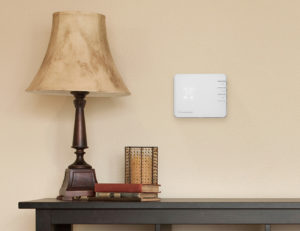These devices can deliver better performance, cheaper bills, and less waste than your current thermostat; and they look good too
The Best Smart Thermostats
There is literally (and by literally we mean figuratively) nothing worse than coming home after a long day of work to find your home freezing (or boiling). It can take hours to warm up (or cool down) and by then, you’ll probably be in bed anyways.
Here’s a quick look at what to consider when you’re buying a smart thermostat, followed by a review of our favorite smart thermostats.
- : Best overall
- : Best for scheduling
- : Best for budget
- : Best for high-voltage systems

Amazon.com List Prices (as of 05/08/2023 11:15 MST).
What to look for in a smart thermostat
If you’re having issues with unreliable climate control or you just want to increase the IQ of your automated home, you should probably invest in a smart thermostat.
Smart thermostats can anticipate your arrival and adjust the climate accordingly. They can sense humidity and movement. They can connect to your other smart devices, like Amazon Echo and Google Home. Best of all, these devices will make your home more efficient, which is good for your wallet and for the environment.
You want to look for a thermostat that’s smart enough to meet your needs but is also easy to install. Thermostats don’t usually come with professional installation, but if you get the setup wrong, your smart thermostat won’t work.
We think the best smart thermostat shouldn't require an expert to install, so all of the smart thermostats on this list are designed for easy self-installation. That’s awesome because you get to save money and feel like a home-improvement boss! In most cases, it should only take you 30 to 60 minutes to get the job done.
Some devices require a C-wire (an extra electricity supply wire) to install. But none of the thermostats reviewed here do.
If you’d prefer not to deal with the wiring yourself, you can hire a professional (which will put you out anywhere from about $100 to $300).
Features that work best for smart thermostats:
- Sensors: Every smart thermostat will have a temperature sensor. But the more advanced devices will also have humidity, motion, and even ambient light sensors.
- Zones: If you’re heating or cooling a large home (or multiple, smaller units), you may want to have varying temperatures in different zones. Some smart thermostats will support multiple zones, but you may have to buy additional components or devices.
- Geofencing: One of the major advantages that smart thermostats have over conventional ones is that they can anticipate your arrival and adjust the climate accordingly. One of the ways they can track you is called geofencing, and it’s essentially enabling location services on your mobile phone.
- Compatibility: Most smart thermostats will work with most HVAC systems, but make sure you read the fine print before you buy to see if the device you want is compatible with your home.
- Smart home integration: If you’ve already got smart appliances or home security systems in your home, then you probably want your smart thermostat to integrate with them. Be sure to check if it’s compatible.
- Voice assistant: “Alexa, turn heat up to 72 degrees.” Doesn’t that sound like a nice way to control the climate? Just be aware: even devices that can integrate with voice assistants, like the Amazon Echo, don’t necessarily have voice command capability built in.
Want to read more?
Ecobee SmartThermostat with Voice Control: Best overall
It’s like a thermostat, digital assistant, and smart speaker put together into a sleek, smart hockey puck.
Sure, your current thermostat might keep your living room or hallway climate controlled, but can it have multiple sensors to ensure that the kids’ bedroom isn’t freezing? Can it track your energy usage? Can it play Spotify? We didn’t think so.
Let us introduce you to the Ecobee SmartThermostat with Voice Control.
This smart thermostat sets a new bar for automated temperature control devices. It’s not just a step above the Ecobee4, but it even outshines its main competitor, the Google Nest Learning Thermostat, by including remote sensors and being more compatible with third-party devices.
Here’s a breakdown of the Ecobee’s impressive features.
The Ecobee Smart Thermostat with Voice Control looks like a high-tech hockey puck. It sports a crystal clear touch screen, two digital microphones, and a surprisingly powerful speaker.
Despite its small size, the device packs 12 terminals into its back plate that can connect to heating, air conditioning, humidifiers, HVAC accessories, and more. On the inside, the Ecobee contains dual-band Wi-Fi technology so it can connect to 2.4GHz or 5GHz networks.
The Ecobee has two main components: the thermostat and the SmartSensors. The smart thermostat itself can read temperature, humidity, proximity, and occupancy. It will be able to tell when someone is in the room and can use geofencing to track when you’re coming home.
The other component is a remote sensor (or multiple sensors) that you can put anywhere in your house. These read temperature only and help ensure that your whole home is climate-controlled accurately. You can purchase extra sensors on Amazon.
The Ecobee SmartThermostat with Voice Control works with a ton of other smart devices and home automation systems, including Apple HomeKit, Amazon Echo, IFTTT, Wink, and Samsung SmartThings.
Here’s a quick primer on home automation. You can see some examples of how automated home devices can integrate to work together in this article (which includes examples for both the Ecobee and Nest thermostats).
Because of this thermostat’s internal microphones and powerful speaker, you can use it much like you would an Amazon Echo. It can stream Pandora, make a phone call, and tell you the weather outside (but it won’t walk your dog—you’ll have to wait for the next generation of smart thermostats for that).
You can control the Ecobee with your voice, the touchscreen on the device, or with a mobile app. The app is probably the easiest way to enable features, like Smart Home/Away, or to set up a schedule.
You can also check your Home IQ, which shows you efficiency reports, historical data, and how outside weather changes your energy use. Paying attention to this data can help you be more green (and save green on your utility bills).
If for some reason the regular Ecobee isn’t cutting it for you, there’s always the Ecobee3 Lite smart thermostat.
Nest Learning Thermostat (3rd Generation): Best for scheduling
The smartest of the smart thermostats is loaded with awesome features.
There are plenty of smart thermostats on the market these days. But there’s “pre-program temperature for seven days” smart and then there’s “learn your daily habits and anticipate your temperature needs” smart. The Nest Learning Thermostat is in the latter category.
This device can track your thermostat use to give you a personalized schedule, so you don’t even have to worry about programming. It’s perfect for those who want the convenience of a Wi-Fi thermostat without the chore of learning a whole new control system.
The Nest Learning Thermostat looks like a small digital clock. This digital thermostat's not quite as sleek as the Ecobee, and it lacks a touch screen, but it does come in multiple colors.
Under the hood are ten temperature sensors and other sensors for humidity, ambient light, and motion. It’s also equipped with Bluetooth radio, 512 MB of memory, and wiring that will hook it up to most HVAC systems.
The Nest Learning Thermostat spends the first week after it’s set up learning your normal daily climate control schedule. It uses that information to create a schedule tailor-fit to your needs.
You can make adjustments to this auto-schedule as time goes on—or ditch it altogether—but it saves you the time and hassle of making a schedule from scratch.
The Nest Learning Thermostat obviously works with other Nest devices, like the Nest Home Security System and the Nest Protect fire alarm. But it also works with third-party devices like WeMo switches and Haiku fans.
You can control the Nest thermostat using Alexa, but it doesn’t have built-in voice controls so you’ll you need to use it in combination with another Alexa device, like a Google Home.
You can control the thermostat using its physical interface (you turn and click a wheel on the outside of the device to select options), but it’s easier to use the mobile app.
On the app you can activate features like Furnace Heads-Up, which tells you how well your heat system is functioning. You can also check the weather, see your energy usage history, set carbon monoxide (CO) thresholds, and set air filter replacement reminders.
You can also try the Google Nest Thermostat E for a little less money.
Honeywell T5+ Smart Thermostat: Best for budget
A surprisingly powerful smart thermostat that won’t dent your bank account (too much).
We all deserve to come home at the end of the day to a cozy climate-controlled space. But not all of us can (or want to) throw down the price of our car payment (or a new Xbox Project Scarlett) to get a smart thermostat device. Thankfully, there’s the Honeywell T5+.
This is the only halfway-decent smart thermostat that is regularly priced under $200. It may not have all of the features and smart home integration as our front-runners, but it will work well with your other budget automated home devices.
The Honeywell T5+ is, unlike the Ecobee and Nest thermostats, not round. It’s square. (Way to be different, T5+!) This digital thermostat's touchscreen display is monochrome rather than color, but it still looks pretty good compared to most thermostats.
This Honeywell Home thermostat has an internal temperature sensor and will hook up to most HVAC systems. It doesn’t have motion or humidity sensors, so you’ll have to rely on other devices (like the Canary All-In-One Security Device) for that.
The T5+ may not be as smart as the Nest Learning Thermostat, but it can use its temperature tracking tools and geofencing technology to learn your daily habits and create a tailor-made schedule for your heating and cooling.
This Honeywell Wi-Fi thermostat can also alert you to irregular temperatures in your home and let you know when it’s time to change your filters.
Whether your digital friend is named Alexa, Siri, or Google Assistant (middle school must have been rough with a name like that), you can integrate the Honeywell T5+ into your automated home system.
But, unfortunately, the T5+ is not compatible with IFTTT devices, which could be a deal-breaker for some.
You can use the touchscreen on the T5+ to adjust most of the basic functions, like temperature, schedule, and Wi-Fi settings. But it’s probably easier and more useful to use the mobile app.
On the app, you can set up geofencing, check the weather forecast, change the temperature of your home, and even control other Honeywell home products that you have hooked up.
Mysa Smart Thermostat: Best for high-voltage systems
Finally, smart climate control for those with baseboard heaters.
For many years, those with baseboard heating systems were being left out of the smart thermostat revolution. But now, thanks to the Mysa Smart Thermostat, you no longer need to fiddle around with a clunky, inaccurate, and decidedly not-smart interface.
This Wi-Fi thermostat is not just an afterthought for those with high-voltage systems. It’s an impressive smart thermostat in its own right, with cutting-edge temperature and humidity control and great smart home integration.
The Mysa Smart Thermostat may be the most elegant-looking device on this list. Its soft white finish and simple temperature display allow it to seamlessly blend into most living areas.
But this elegance does come with a drawback: most of the thermostat’s functions must be controlled through the mobile app.
The Mysa Smart Thermostat can connect to 110, 120, 208, 220, and 240 volt line heating systems, and it can support up to 3800 watts. (That’s about four times as much power as a window AC unit!)
The bad news is that the Mysa Smart Thermostat is not able to control a conventional HVAC system. So, if you happen to have baseboard and forced air heating systems in your house, then you’ll need to get another smart thermostat to control the forced air system.
The good news is, the Mysa Smart Thermostat has the best smart home integration out of all the devices reviewed here, which means this Wi-Fi thermostat should integrate well with just about any other thermostat, whether it’s the Ecobee, Nest, or something else.
As we mentioned above, the Mysa Smart Thermostat’s built-in interface can only control the temperature. If you want to do anything more complicated than turn the heat up a few degrees, you’ll need to use the mobile app.
With the app, you can set a custom schedule, track humidity, or turn on the “eco mode” or vacation mode. You can also set up geofencing, which will allow the thermostat to track your comings and goings to offer more efficient climate control. (Kind of creepy, but very useful.)
Recap: Best smart thermostats
Buying a smart thermostat can save you time and money on your energy bill. Perhaps most importantly, it can help to cut your use of non-renewable resources, like oil and gas. Plus, you get a cool, Star Trek–looking device on your wall.
Here’s a quick review of our picks for the best smart thermostats.
- The Ecobee SmartThermostat with Voice Control is basically a thermostat, digital assistant, and smart speaker all rolled into one. It’ll integrate with most HVAC and home automation systems so the only downside is that big price tag.
- The Nest Learning Thermostat (3rd Generation) is the smartest device on this list. It’ll learn your habits and create an ideal schedule for comfort and energy efficiency. But it doesn’t score quite as high as the Ecobee on compatibility and features.
- The Honeywell T5+ Smart Thermostat is a perfectly decent smart thermostat that will cost you less than $100. That’s a screamin’ deal for a device with auto-scheduling and a wide compatibility with automated home systems.
- The Mysa Smart Thermostat is the only device on this list that can handle baseboard heating and other high-voltage systems. Its elegant display, great compatibility, and cheap price tag make it a steal of a deal.
You really can’t go wrong with any of these smart home devices, but everyone’s needs are different, so we’d love to know what you think. What’s the best smart thermostat on the market? Shout it out in the comments section below.
Smart thermostat FAQ
We think that the ease of use, connectivity, and exciting features found in smart thermostats are definitely worth the trouble, even if you’ve never changed thermostats before.
Smart thermostats can definitely help you save money on your monthly heating and cooling bill.
A study by the Environment Protection Agency determined that smart thermostats can save users about 8% of their monthly heating and cooling costs. That's about $50 a year but can be more or less than that depending on the user's climate and preferences.
Saving money with smart thermostats ultimately correlates with how often the thermostat is turned on or off. And with a smart thermostat, you can set temperature schedules, implement motion-censored triggers, or even receive energy-saving tips straight from your digital smart thermostat screen.
For example, if you work away from home during the day, the Department of Energy claims that setting your thermostat back about 7°–10° can save you about 10% a year on your heating and cooling bills.
All of the thermostats mentioned here include DIY installation, which requires zero extra cost for you.
If you're trying to install a more intricately-connected smart thermostat or have a more complicated wiring system, hiring professional help is probably a better idea than risking electrocution. Professional installation of a smart thermostat will cost you about $100 to $300, give or take.
Yes. But without Wi-Fi, your smart thermostat will function like a dumb one. You'll be able to operate its basic features, but you'll need a Wi-Fi connection to access anything like monitoring, live updates, and remote control.
You can! All of our thermostat recommendations can be easily installed yourself. But to ensure your smart thermostat installation goes as breezy as possible, make sure you know that your smart thermostat is compatible with your current HVAC system.
Certain content that appears on this site comes from Amazon.com. This content is provided "as is" and is subject to change or removal at any time. Product prices and availability are accurate as of the date/time indicated and are subject to change. Any price and availability information displayed on Amazon.com at the time of purchase will apply to the purchase of this product. Reviews.org utilizes paid Amazon links.
Related Articles






